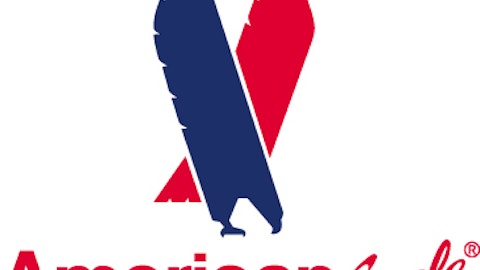Yoga and athletic apparel retailer Lululemon Athletica inc. (NASDAQ:LULU) has been one of the hottest growth stocks over the past five years, soaring 360% as the company tripled its annual revenue. The company, which grew out of a single yoga studio/store in Vancouver, managed to grow out of its niche and become a mainstream phenomenon, prompting companies such as The Gap Inc. (NYSE:GPS), NIKE, Inc. (NYSE:NKE), Under Armour Inc (NYSE:UA), and PVH Corp (NYSE:PVH)’s Calvin Klein to produce “yoga-inspired” athletic apparel to attract more female shoppers.
However, Lululemon plunged this year on the widely publicized ‘sheer pants fiasco,’ which has raised major questions regarding the sustainability of the company’s growth. Although the company recently announced that its production schedule was back on track earlier than expected, was its slip symptomatic of other operational deficiencies?
Growing (stretching) pains
Last month, shares of Lululemon Athletica inc. (NASDAQ:LULU) plunged after the company announced that it was recalling 17% of its yoga pants for being too sheer. The Luon (nylon and lycra blend) pants were recalled after store staff reported that the fabric became nearly transparent when stretched. The mess raised concerns about low quality outsourcing, and will cost Lululemon an estimated $67 million to fix. It will also reduce first quarter revenue by up to $17 million.

Analysts believed that the company’s overzealous expansion led to a loss of control over its supply chain. Lululemon, which has a small footprint of 200 stores, is constantly being compared to large retailers such as Gap, which has stepped up the competition with its Athleta yoga apparel brand.
Many customers also criticized CEO Christine Day for emphasizing quantity and lower margins over quality. Carolyn Beauchesne, author of the blog Lululemon Addict, wrote, “Day has ruined everything special about Lululemon. The bulletproof quality, the fit, the femininity, the ‘lululemoness’ of the product.”
A pleasant surprise
However, Lululemon Athletica inc. (NASDAQ:LULU) recently surprised Wall Street that it would be able to fully replenish its supply of lost pants by May or early June. This is much earlier than the company’s prior forecast for a July or August recovery.
Lululemon’s efficient recovery impressed many analysts, such as Cannacord Genuity analyst Camilio Lyon, who suggests that the company may actually have helped the company. “We believe demand for Lululemon gear has not suffered from this transitory quality control issue, and likely benefited from the publicity,” he stated in a note to investors.
The early end to the sheer pants debacle prompted Lyon to raise his full year EPS estimates to $2.08, up from his prior estimate of $2.00. Lyon also increased his full-year revenue expectation from $1.66 billion to $1.69 billion. Lyon currently has a ‘buy’ rating on the stock with an $87 price target.
Lululemon also stated that it discovered the flaw in its testing system that Eclat Textiles had referred to. The company’s chief product officer, Sheree Watson, shouldered most of the blame and stepped down.
Not the first time
Yet this isn’t the first time Lululemon dropped the ball with quality control. In 2007, the company’s Vitasea seaweed-based fabric, which the company claimed to release “marine amino acids, minerals, and vitamins into the skin” was found by the New York Times to not contain any seaweed at all. Lululemon responded by removing the health claims, but continued using Vitasea fabric.
In 2010, Lululemon recalled its reusable shopping bags after tests revealed that they contained lead. Several incidents also occurred over the past year with color bleeding with its pants and transparency problems with swimwear. Therefore, while investors are breathing a sigh of relief over the early end to the sheer pants saga, there are still major concerns hanging over the company’s quality control processes.
Mind the Gap
I think these lapses in quality control indicate that Lululemon is trying too hard to be the next Gap, since that is what Wall Street expects. But I think Lululemon has a few lessons to learn from Gap’s growth. A decade ago, Gap was hit by charges of using child labor in China, Southeast Asia, India and Europe for its outsourcing needs. As a result, the company had to terminate hundreds of supply deals, and as a result, its operating margin slid 40% between 2004 and 2007.
